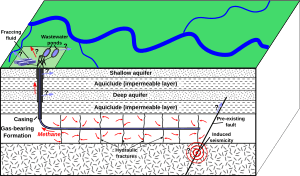Fracking facts for kids
Fracking, also known as hydraulic fracturing, is a way to get oil and natural gas from deep underground. It involves pushing a special liquid into rock layers at very high pressure. This pressure creates tiny cracks in the rock, which helps release the oil and gas trapped inside. While this can happen naturally, people now use it to get energy resources like oil and natural gas from a type of rock called shale.
How Fracking Works
Sometimes, cracks like these form naturally in rocks. For example, they can appear around certain rock formations called dikes. These natural cracks allow oil and gas to move from where they are formed to places where they can be collected. People first started using hydraulic fracturing to get substances out of rocks in 1947.
The modern way of fracking, called 'horizontal slickwater fracturing', began in 1998. This new method made it possible to get natural gas from shale rock in a way that made money. When the special liquid is injected at high pressure, it creates new pathways or channels in the rock. This helps more oil and gas flow out, making it easier to collect these hydrocarbons, which we use as fuel.
By 2010, it was thought that 60% of all new oil and gas wells around the world were using hydraulic fracturing. As of 2012, about 2.5 million hydraulic fracturing operations had been done on oil and gas wells globally. More than one million of these were in the United States.
Benefits and Concerns of Fracking
People who support hydraulic fracturing often talk about the economic benefits. Fracking allows us to reach huge amounts of oil and gas that were once too difficult or expensive to get. This can create jobs and provide more energy for countries.
However, people who are against fracking worry about its possible effects on the environment. Some concerns include:
- Contamination of groundwater: There are worries that the liquids used in fracking, or the natural gas itself, could get into underground water sources.
- Risks to air quality: The process can release gases and other substances into the air.
- Movement of chemicals: Fracking chemicals and gases might move up to the surface.
- Surface spills: Spills of fracking liquids or wastewater on the ground can cause pollution.
- Health effects: There are concerns about how these environmental issues might affect people's health.
Because of these concerns, hydraulic fracturing has been looked at very closely. Some countries have even stopped or banned it for a while. However, some of these countries, like the United Kingdom, have recently lifted their bans. Instead of a complete ban, they now have rules and regulations for fracking. This is partly because the UK has very large natural gas reserves that could be reached using fracking.
Images for kids
-
Poster against hydraulic fracturing in Vitoria-Gasteiz (Spain, 2012)
See also
 In Spanish: Fracturación hidráulica para niños
In Spanish: Fracturación hidráulica para niños













